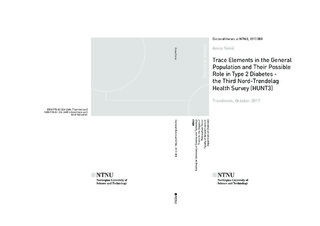| dc.contributor.advisor | Flaten, Trond Peder | |
| dc.contributor.advisor | Midthjell, Kristian | |
| dc.contributor.advisor | Åsvold, Bjørn Olav | |
| dc.contributor.author | Simic, Anica | |
| dc.date.accessioned | 2017-11-08T11:49:21Z | |
| dc.date.available | 2017-11-08T11:49:21Z | |
| dc.date.issued | 2017 | |
| dc.identifier.isbn | 978-82-326-2685-4 | |
| dc.identifier.issn | 1503-8181 | |
| dc.identifier.uri | http://hdl.handle.net/11250/2464918 | |
| dc.description.abstract | Access to reliable information on the elemental contents of the human body is crucial to understand the roles these elements may have in the maintenance of human health. Establishing trace element blood levels in a general population can help elucidate potential causes of diseases related to natural and anthropogenic sources of these elements; it can also provide a baseline for potential future biomonitoring that could assess and evaluate temporal changes in the trace element status in populations. For the toxic elements such population studies can provide an important source for considering the total exposure of such elements through food, water and air, and may thus warn us on potentially dangerous exposure or contamination.
Several epidemiological studies have indicated that a number of trace elements may play a role in type 2 diabetes (T2D). To address the question on when anomalous levels of trace elements begin to appear in T2D development, one could measure trace elements levels in the different stages of the disease in cross-sectional studies.
In the present dissertation, whole blood samples and data collected in the third wave of the population-based Nord-Trøndelag Health Survey (HUNT3) were used in cross-sectional studies to investigate: 1) the background levels of 28 trace elements in the population of Nord-Trøndelag County and possible regional differences in the trace element levels; 2) potential relations between trace element blood levels and T2D in two case-control studies, one in persons who did not have a T2D diagnosis when blood samples were drawn, and the other in persons with an established T2D diagnosis.
The whole blood concentrations of 28 trace elements in this Norwegian population were found to be well within reference levels, suggesting low exposure to toxic elements in the residents of Nord-Trøndelag County. Our results imply that geographical area, lifestyle, and several socio-demographic characteristics markedly influence the blood concentrations of several trace elements in humans, particularly for the elements arsenic, mercury, bromine, boron and selenium, for which the marine environment may be an important source of exposure.
Our studies on trace element blood levels in T2D showed significant associations of lower indium, lead and magnesium, but higher boron, calcium and silver levels with prevalent T2D, and lower bromine, but higher chromium, iron, nickel, silver and zinc levels in the early phase of T2D. Increasing blood levels of calcium were associated with diabetes duration, which suggest that calcium might be linked to disease progression or antidiabetic treatment.
In future studies of trace elements in the general population, emphasis should be placed on well-characterized prospectively followed population-based cohorts (such as the HUNT population), where detailed information is available on a wide range of socio-demographic and lifestyle characteristics, paying particular attention to nutritional factors. Future studies on trace elements in T2D should focus on changes in trace element levels over longer periods (including samples collected before the disease is manifest); on the speciation of trace elements in different intracellular and extracellular compartments, and on how particular glucose-lowering drugs may affect levels of especially essential trace elements in diabetic patients. | nb_NO |
| dc.language.iso | eng | nb_NO |
| dc.publisher | NTNU | nb_NO |
| dc.relation.ispartofseries | Doctoral theses at NTNU;2017:308 | |
| dc.relation.haspart | Paper 1: A. Simić, T. Syversen, A.F. Hansen, B.O. Åsvold, T.M. Ciesielski, P.R. Romundstad, K. Midthjell, S. Lierhagen and T.P. Flaten. Trace elements in whole blood in the general population in Nord-Trøndelag County, Norway: The HUNT3 Survey | nb_NO |
| dc.relation.haspart | Paper 2: Simic, Anica; Hansen, Ailin Falkmo; Åsvold, Bjørn Olav; Romundstad, Pål Richard; Midthjell, Kristian; Syversen, Tore; Flaten, Trond Peder. Trace element status in patients with type 2 diabetes in Norway: The HUNT3 Survey. Journal of Trace Elements in Medicine and Biology 2017 ;Volum 41. s. 91-98
https://doi.org/10.1016/j.jtemb.2017.03.001 | nb_NO |
| dc.relation.haspart | Paper 3: Hansen, Ailin Falkmo; Simic, Anica; Åsvold, Bjørn Olav; Romundstad, Pål Richard; Midthjell, Kristian; Syversen, Tore; Flaten, Trond Peder. Trace Elements in Early Phase Type 2 Diabetes Mellitus – a Population-based Study. The HUNT Study in Norway. Journal of Trace Elements in Medicine and Biology 2017 ;Volum 40. s. 46-53
https://doi.org/10.1016/j.jtemb.2016.12.008 | nb_NO |
| dc.title | Trace Elements in the General Population and Their Possible Role in Type 2 Diabetes - the Third Nord-Trøndelag Health Survey (HUNT3) | nb_NO |
| dc.type | Doctoral thesis | nb_NO |
| dc.subject.nsi | VDP::Mathematics and natural science: 400::Chemistry: 440 | nb_NO |
